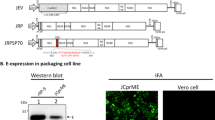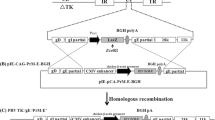Abstract
Domain III of Japanese encephalitis virus (JEV) envelope protein (E-DIII) was synthesized in E. coli as a fusion protein containing maltose-binding protein (MBP-E-DIII) or six contiguous histidine residues (His-E-DIII) at its N-terminus. MBP-E-DIII was found both in the soluble as well as the insoluble fraction of the bacterial lysate, while His-E-DIII was found exclusively in the inclusion bodies. These purified proteins were examined in mice for their immunogenicity in presence of an aluminium hydroxide based-adjuvant Alhydrogel and Freund’s adjuvant. While both proteins generated anti-JEV antibodies that neutralized JEV activity in vitro, His-E-DIII generated higher antibody titers than MBP-E-DIII. Mice immunized with His-E-DIII in presence of Alhydrogel generated antibody titers similar to those induced by the commercial vaccine and protected mice against lethal JEV challenge.


Similar content being viewed by others
References
Bharati K, Vrati S (2006) Japanese encephalitis: development of new candidate vaccines. Expert Rev Anti Infect Ther 4:313–324
Cecilia D, Gould EA (1991) Nucleotide changes responsible for loss of neuroinvasiveness in Japanese encephalitis virus neutralization-resistant mutants. Virology 181:70–77
Crill WD, Roehrig JT (2001) Monoclonal antibodies that bind to domain III of dengue virus E glycoprotein are the most efficient blockers of virus adsorption to Vero cells. J Virol 75:7769–7773
Halstead SB, Jacobson J (2003) Japanese encephalitis. Adv Virus Res 61:103–138
Kapust RB, Waugh DS (1999) Escherichia coli maltose-binding protein is uncommonly effective at promoting the solubility of polypeptides to which it is fused. Protein Sci 8:1668–1674
Kaur R, Sachdeva G, Vrati S (2002) Plasmid DNA immunization against Japanese encephalitis virus: immunogenicity of membrane-anchored and secretory envelope protein. J Infect Dis 185:1–12
Kolaskar AS, Kulkarni-Kale U (1999) Prediction of three-dimensional structure and mapping of conformational epitopes of envelope glycoprotein of Japanese encephalitis virus. Virology 261:31–42
Lin CW, Wu SC (2003) A functional epitope determinant on domain III of the Japanese encephalitis virus envelope protein interacted with neutralizing-antibody combining sites. J Virol 77:2600–2606
Lindenbach BD, Rice CM (2001) Flaviviridae: the viruses and their replication. In: Knipe DM, Howley PM (eds) Fields virology, 4th edn. Lippincott Williams & Wilkins, Philadelphia, pp 991–1041
Mason PW, Dalrymple JM, Gentry MK, McCown JM, Hoke CH, Burke DS, Fournier MJ, Mason TL (1989) Molecular characterization of a neutralizing domain of the Japanese encephalitis virus structural glycoprotein. J Gen Virol 70(Pt 8):2037–2049
Plesner AM (2003) Allergic reactions to Japanese encephalitis vaccine. Immunol Allergy Clin North Am 23:665–697
Poland JD, Cropp CB, Craven RB, Monath TP (1990) Evaluation of the potency and safety of inactivated Japanese encephalitis vaccine in US inhabitants. J Infect Dis 161:878–882
Reed LJ, Muench H (1938) A simple method of estimating 50 per cent end-points. Am J Hyg 27:493–497
Rey FA, Heinz FX, Mandl C, Kunz C, Harrison SC (1995) The envelope glycoprotein from tick-borne encephalitis virus at 2 A resolution. Nature 375:291–298
Saini M, Vrati S (2003) A Japanese encephalitis virus peptide present on Johnson grass mosaic virus-like particles induces virus-neutralizing antibodies and protects mice against lethal challenge. J Virol 77:3487–3494
Seif SA, Morita K, Igarashi A (1996) A 27 amino acid coding region of JE virus E protein expressed in E. coli as fusion protein with glutathione-S-transferase elicit neutralizing antibody in mice. Virus Res 43:91–96
Seif SA, Morita K, Matsuo S, Hasebe F, Igarashi A (1995) Finer mapping of neutralizing epitope(s) on the C-terminal of Japanese encephalitis virus E-protein expressed in recombinant Escherichia coli system. Vaccine 13:1515–1521
Simmons M, Nelson WM, Wu SJ, Hayes CG (1998) Evaluation of the protective efficacy of a recombinant dengue envelope B domain fusion protein against dengue 2 virus infection in mice. Am J Trop Med Hyg 58:655–662
Singh SM, Panda AK (2005) Solubilization and refolding of bacterial inclusion body proteins. J Biosci Bioeng 99:303–310
Sumiyoshi H, Mori C, Fuke I, Morita K, Kuhara S, Kondou J, Kikuchi Y, Nagamatu H, Igarashi A (1987) Complete nucleotide sequence of the Japanese encephalitis virus genome RNA. Virology 161:497–510
Vrati S, Agarwal V, Malik P, Wani SA, Saini M (1999) Molecular characterization of an Indian isolate of Japanese encephalitis virus that shows an extended lag phase during growth. J Gen Virol 80:1665–1671
World Health Organization (1998) Japanese encephalitis vaccines. Wkly Epidemiol Rec 73:337–344
Wu SC, Lian WC, Hsu LC, Liau MY (1997) Japanese encephalitis virus antigenic variants with characteristic differences in neutralization resistance and mouse virulence. Virus Res 51:173–181
Wu SC, Yu CH, Lin CW, Chu IM (2003) The domain III fragment of Japanese encephalitis virus envelope protein: mouse immunogenicity and liposome adjuvanticity. Vaccine 21:2516–2522
Acknowledgments
This work was supported by the Department of Biotechnology, Government of India grant no. BT/PR2765/Med/14/329/2001 and the core grant of the National Institute of Immunology, New Delhi.
Author information
Authors and Affiliations
Corresponding author
Additional information
Alka and Kaushik Bharati contributed equally to this work.
Rights and permissions
About this article
Cite this article
Alka, Bharati, K., Malik, Y.P.S. et al. Immunogenicity and protective efficacy of the E. coli-expressed domain III of Japanese encephalitis virus envelope protein in mice. Med Microbiol Immunol 196, 227–231 (2007). https://doi.org/10.1007/s00430-007-0043-4
Received:
Published:
Issue Date:
DOI: https://doi.org/10.1007/s00430-007-0043-4




